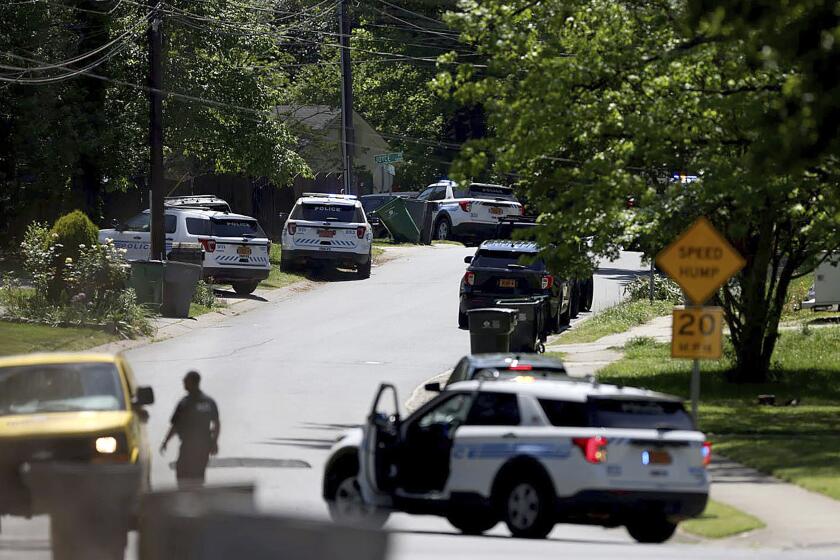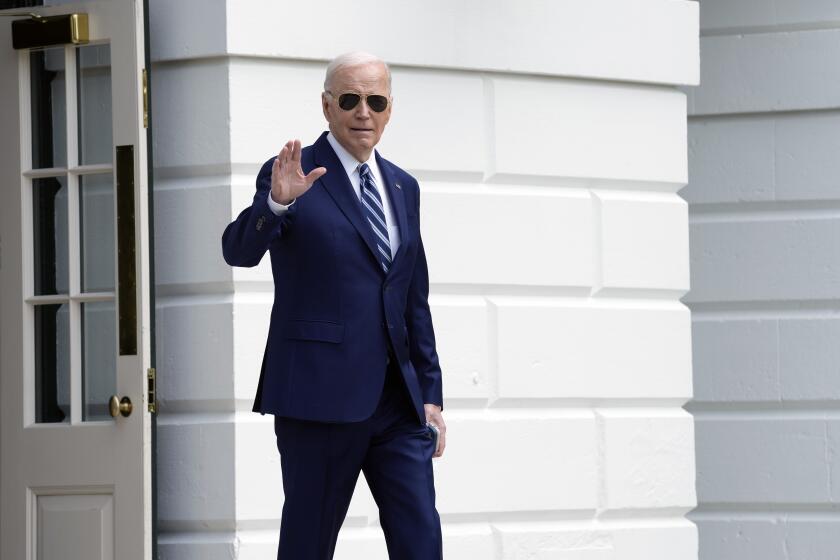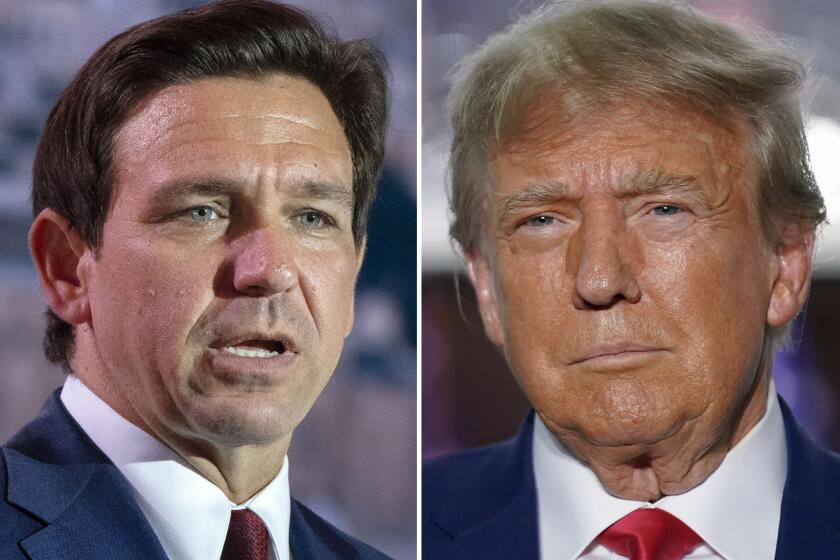To Alaska’s Big Dreamers, No Bridge Is Too Far
Walter J. Hickel never lacked for critics during either of his stints as governor of Alaska. Many took umbrage at his staunchly pro-development views, which he once summarized this way: “Virginity is a good thing, but birth is necessary for progress.”
But nobody ever accused Wally Hickel of failing to think big. And even today, at 86, excitedly pacing the floor in his investment-company offices at the Hotel Captain Cook, Hickel predicts that his biggest dream of all will yet come to pass.
“Someday, they’ll build it,” he says, holding up an old promotional poster for his “Alaska-California Sub-Oceanic Fresh Water Transport System” -- a $150-billion pipeline that would tap the glacier-fed wild rivers of the Last Frontier and deliver the water 2,000 miles to Los Angeles.
“I may be dead by then,” adds Hickel, “but they’ll build it.”
Asked how much Angelenos would have to pay for the water, he replies: “Depends how thirsty they are.”
Outlandish, perhaps, though so is another unrealized Hickel brainchild -- a $30-billion, 55-mile rail and highway tunnel under the Bering Strait, connecting Alaska with Siberia.
In this most giant of all the states, with vast natural resources and an edge-of-the-world mentality, Hickel is just one of many Alaskans who dream of carving the landscape or reaping its resources on a fantastic scale.
From its frontier territory days through its admission as a state in 1959 and on to the present, Alaska has attracted, and even elected, the biggest dreamers of all.
It hasn’t been a great year for Alaskan schemers, of course: The state’s three-person congressional delegation has been widely ridiculed for backing federal projects that critics describe as silly “bridges to nowhere,” textbook examples of porkbarrel spending run amok.
And in the 1970s, then-Sen. Mike Gravel (D-Alaska) proposed advancing federal funds to build a huge Teflon dome above the Tokositna River. As he envisioned it, “Denali City” would have contained malls, condos, a golf course, hotels and a conference center, boasting year-round 72-degree temperatures and a stunning view of Mt. McKinley, America’s highest peak. (He hasn’t gained a lot of traction with another grand scheme: Now 76 and out of office for 25 years, Gravel announced recently that he was running for president.)
Although many Americans look at Alaska and see a magnificent wilderness that should largely be left alone, many Alaskans look at Alaska and see much to be done.
As current Gov. Frank H. Murkowski, a Republican, put it in his State of the State address this year, clearly taking umbrage at Alaska’s reputation for seeking federal money for crackpot schemes: “Alaska does not just take. We give, and we have the capacity to give much, much more -- if permitted to do so.”
Murkowski was referring to, among other things, another very big idea that he and many other political figures and moguls here favor: a $50-billion pipeline to send about 100 trillion cubic feet of natural gas from beneath Alaska’s northern tundra to the Lower 48.
Lawmakers and three big oil companies are trying to hammer out a financing plan for the line, which could take a decade or more to complete. It could employ thousands and rival the Trans-Alaska oil pipeline in engineering complexity -- assuming the epic project survives both a challenge by environmentalists and the vagaries of the world gas market.
They’re not the first to search for big payoffs; so did Russian fur traders and whalers and American gold prospectors as well as oil and gas men. Many such plans panned out, of course.
Even today, Alaskan leaders are backing big projects -- including drilling in the Arctic National Wildlife Refuge and creation of one of the world’s biggest gold mines, near Bristol Bay -- despite widespread environmental opposition.
And they are proposing big solutions -- and major federal funding -- to respond to a big and growing Alaska problem: rising temperatures.
Two coastal villages, Shismaref and Newtok in far western Alaska, are threatened by erosion that many scientists link to global warming, and the villages are planning to move entirely to safer ground. Some Alaska contractors say billions of dollars may be needed in coming decades to anchor homes and other buildings more deeply into the thawing permafrost.
But for all the oil, gold, copper and fish plucked from the waters and wilderness of Alaska, many of the most intriguing -- or horrifying -- ideas exist only on paper.
Some of Hickel’s ideas were so, well, cosmic that even his friends joked that he lived in “Wallyworld,” a place not quite synonymous with reality.
On the other hand, Hickel, a onetime boxer from Kansas, made millions as a real estate developer. And, both as governor and as President Nixon’s Interior secretary, he was a driving force behind approval and construction of the 29-year-old, 800-mile Trans-Alaska oil pipeline.
“Big projects define a civilization,” explains Hickel, whose retro-style investment-company office is a throwback to the ‘60s, with pink and orange tones, carpeted walls, and a model in the corner of a DC-10 from long-defunct Western Airlines.
“My question has always been: Why war -- why not big projects?” he adds. Hickel was fired from Nixon’s Cabinet after suggesting that the president pay more attention to young Vietnam War protesters. “Big projects can keep countries from going to war with each other.”
The quirky history of Alaska schemes and the people who dreamed them up is a cottage industry unto itself. State historians can rattle off a long list with surprising ease.
“Alaska has always been a place that attracts fanciful dreamers,” says Gunnar Knapp, a professor of economics at the University of Alaska-Anchorage Institute of Social and Economic Research. “And from time to time, there have been big projects that have come to pass.” He cites the Alaska Railroad, built from 1915 to 1923 (which Murkowski favors extending from Fairbanks to Nome); the Alaska Highway, built during World War II; and the Trans-Alaska Pipeline System, or TAPS.
“They stand out because they have to be big,” Knapp says. “The nature of Alaska as a faraway and expensive place makes them by definition a huge thing.”
Another Alaska academic would draw one distinction, though.
It is “useful to differentiate between projects that had to be big because of Alaska’s remoteness, and projects that were big ... well, because someone wanted them that way -- the grandiose, I guess?” says Timothy M. Rawson, an associate professor of history at Alaska Pacific University in Anchorage.
“I’d put the Alaska Highway and the TAPS into the first category. They weren’t built bigger than was needed, but just had to be big.”
He’d put “domed cities” and Project Chariot -- perhaps the most outlandish Alaska scheme of all -- in the second category.
In the late 1950s, Edward Teller, the American physicist known as “the father of the hydrogen bomb,” came to Alaska with a scheme to excavate a new harbor in frigid northwest Alaska, 125 miles north of the Arctic Circle -- by setting off five thermonuclear bombs. Project Chariot, as Teller came to call it, was to open the Arctic sea lanes to shipping (a goal that human-induced climate change may be accomplishing a half-century later).
Proponents saw the idea as a fitting tribute to a place just then gaining statehood.
“We think the holding of a huge nuclear blast in Alaska would be a fitting overture to the new era which is opening for our state,” wrote the editor of the Fairbanks News-Miner.
But Project Chariot was not to be, much to Teller’s regret.
Gravel and Hickel no longer represent their state, but Alaskans have continued to send leaders to Washington who want big things done in the Last Frontier -- and whose plans are not often universally recognized as brilliant.
For the “bridges to nowhere,” Alaska’s congressional delegation earned a Golden Fleece Award for wasteful spending from the watchdog group Taxpayers for Common Sense. The projects were officially removed from the federal budget, but the Alaskan lawmakers succeeded in procuring enough federal highway money for their state that design and planning for the bridges have continued apace.
Developers say the proposed bridges in Anchorage and Ketchikan don’t go “nowhere” but instead to currently undeveloped areas in need of development. And many Alaskans seem to agree.
“We do elect people who think big to be our governors, or to represent us in Washington,” says economics professor Knapp. He adds that Alaskans tend to believe it is possible to draw resources and still be a good steward of the environment.
Polls routinely show that Alaskans favor drilling for oil in the Arctic refuge in much greater percentages than do Americans as a whole.
“That kind of thinking is very representative of people in Alaska,” says Knapp. “If there’s oil or gas, it should be drilled; if there’s timber, it should be cut; if there’s gold, it should be mined.”
More to Read
Start your day right
Sign up for Essential California for news, features and recommendations from the L.A. Times and beyond in your inbox six days a week.
You may occasionally receive promotional content from the Los Angeles Times.






